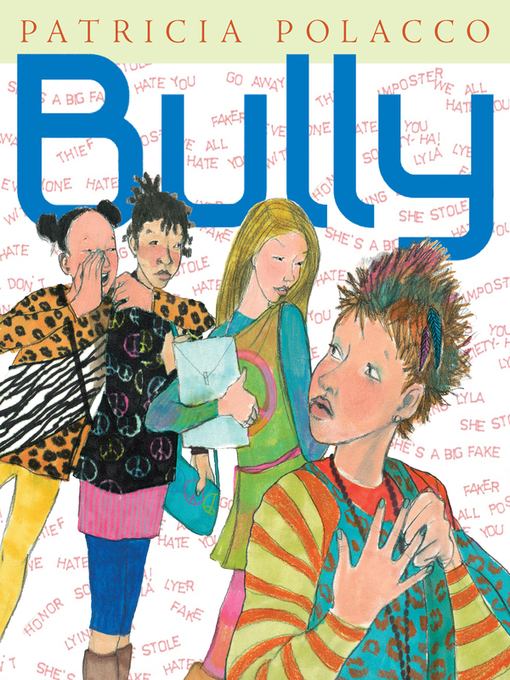
Bully
فرمت کتاب
ebook
تاریخ انتشار
2012
Lexile Score
630
Reading Level
2-3
ATOS
4.1
Interest Level
4-8(MG)
نویسنده
Patricia Polaccoشابک
9781101647851
کتاب های مرتبط
- اطلاعات
- نقد و بررسی
- دیدگاه کاربران
نقد و بررسی

cutipup200511 - This book is about a girl named Lila and she was a new girl at her school and on her way to the cafeteria and she met a boy named Jamie and when he asked her he was new he was new to the school and they were both in 6th grade so a little while of them of talking they became friends so every Friday Jami, Lila would watch Sci-Fi movies together

August 6, 2012
Polacco’s middle-school variation on Mean Girls is an overwrought but compelling literary hybrid: it reads like a novella with pictures. Sixth-grader Lyla and her brother, Jack, are new kids at a Bay Area school with a cutthroat social scene. Lyla is accepted into the popular girls’ clique, but grapples with the fact that the very same kids are bullying Jack and a boy named Jamie on Facebook, as well as in the hallways and lunchroom. That would be plenty to digest, but Polacco raises the stakes to a lurid level with a stolen achievement test and a tragic back story for the clique’s leader, turning potentially empathetic readers into rubberneckers. While the story’s emphasis on cyber-bullying is important and timely, Polacco’s message is delivered with a heavy hand. Visually, though, it’s striking. As always, Polacco (The Art of Miss Chew) is an exuberantly expansive stylist, and a master of emotional immediacy: her pencil and marker spreads explode with color and expressiveness. Few artists are better equipped to capture the hothouse that is early adolescent school life, complete with its all-important fashion parade. Ages 7–up.

August 1, 2012
Despite good intentions, Polacco's current take on this particular hot topic falls short. First and foremost, it seems unlikely that the message will ever reach its intended audience. Extensive text and challenging vocabulary make it clear that although the story is told in Polacco's typical picture-book format, it's really aimed at older children. Lyla and her friends (and enemies) appear to be in middle school, but the simplistic plot won't keep kids that age engaged. New at school, Lyla first finds a good friend in fellow newcomer Jamie. When her cheerleading talents are revealed, Lyla is adopted by the in crowd. Savvy readers won't be surprised when she struggles to balance her friendships or by her eventual decision to stand up for Jamie. That decision leads to an accusation of cheating and an all-out campaign of cyberbullying. While Polacco gets quite a few things just right--the three mean girls' body language perfectly expresses their snotty attitude, and Lyla's pleasure in being part of the popular group is entirely believable--overall, the plot is predictable. Ending with a question for readers emphasizes the bibliotherapeutic goal and further weakens the potential impact. Unlike Polacco's Thank You, Mr. Falker (1998)--an affecting, personal look at the pain cruel kids can inflict on those they perceive as different--this contemporary effort won't move readers to better understand themselves or others. (Picture book. 8-12)
COPYRIGHT(2012) Kirkus Reviews, ALL RIGHTS RESERVED.

August 1, 2012
Gr 3-5-Lyla begins sixth grade at a new school in the San Francisco Bay area and makes friends with Jamie, a short, overweight boy with a big smile. She gets good grades, becomes a cheerleader, and attracts the attention of a clique of popular girls. For a while she successfully balances her friendship with Jamie and her time with Gage, Kenyon, and Maeve-until she sees them writing hurtful things on the Facebook walls of their classmates. When she breaks with the clique, Gage warns her that no one dumps them. Their revenge comes in February, when Lyla is accused of stealing one of the state tests. Horrible messages ("EVERYBODY HATES YOU," "OMG WHAT A CHEAT," and "DROP DEAD" among them) appear on Facebook, MySpace, YouTube, and her cell phone. Helpless to clear her name, she turns to Jamie, whose computer skills trace the messages back to Gage, who stole the missing test. Gage must take responsibility to avoid suspension, but Lyla and Jamie wonder how much will change. Will they hope for the best or transfer to another school? Rendered in pencils and markers, the artwork realistically portrays-through their body language and wonderfully expressive hands-what these youngsters are feeling. Polacco captures the insidiousness of cyberbullying and, in a letter to her readers, warns again of its dangers. Paired with the author's Thank You, Mr. Falker (Philomel, 1998), this picture book will spark intense and much-needed discussions.-Mary Jean Smith, formerly at Southside Elementary School, Lebanon, TN
Copyright 2012 School Library Journal, LLC Used with permission.

December 1, 2012
Grades 3-7 Like Toney Allman's nonfiction title Mean behind the Screen (2008), Polacco's powerful picture book dramatizes how online abuse has intensified the cruelty of bullying. New to her school, Lyla links up with Jamie, another new kid in her sixth-grade class, and they become close friends. Dramatic line-and-watercolor artwork shows the two outsiders in the lunchroom, excluded by the geeks, the nerds, the toughs, the sports kids, and especially by the celebrity table of the most popular girls. After Jamie gives Lyla good advice about getting a cell phone and a laptop and helps her create a Facebook page, she feels more connected. Then, though, Lyla becomes so cool that the popular crowd invites her to sit with thembut only if she breaks from Jamie. And she does, until they show her what fun they are having humiliating her friend on Facebook with cruel images and insults. After Lyla stands up to the celebrities, they take ugly revenge. Kids will recognize the charged scenarios of anger and hurt and the seething contemporary middle-school social scene. Great for group discussion.(Reprinted with permission of Booklist, copyright 2012, American Library Association.)

























دیدگاه کاربران